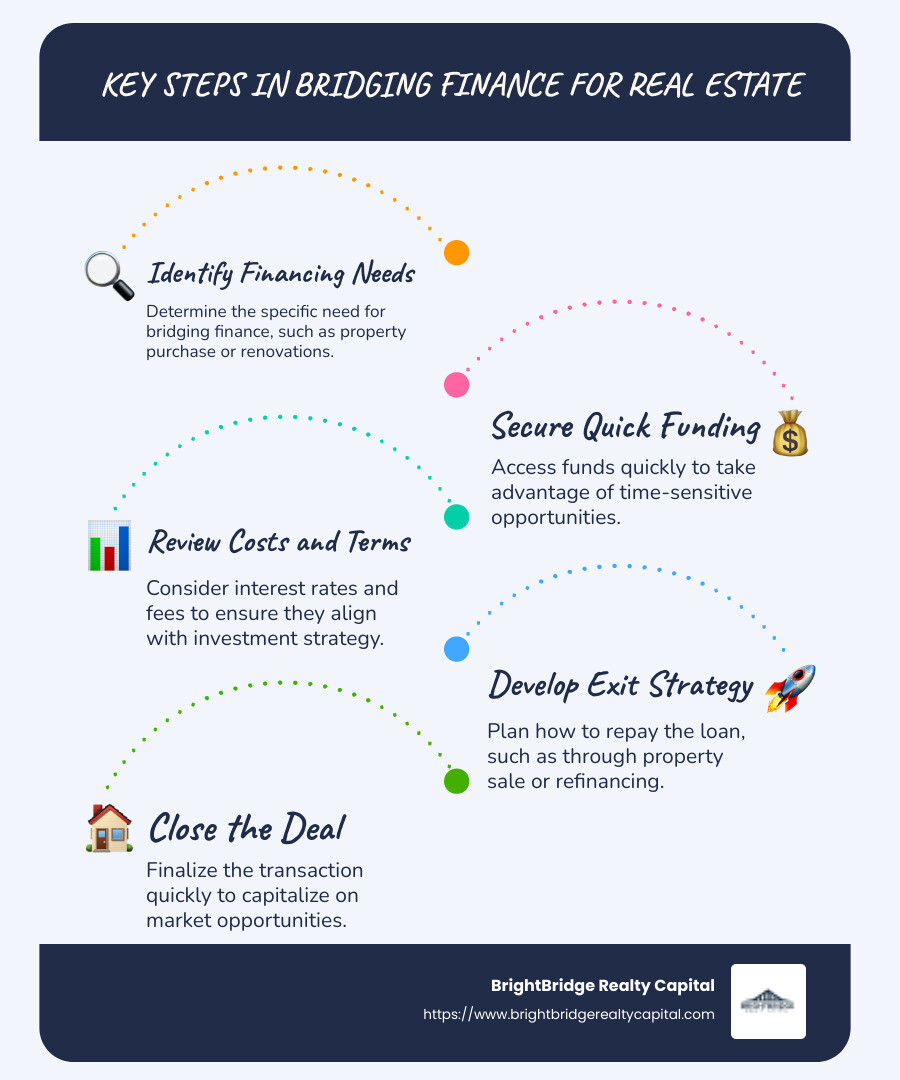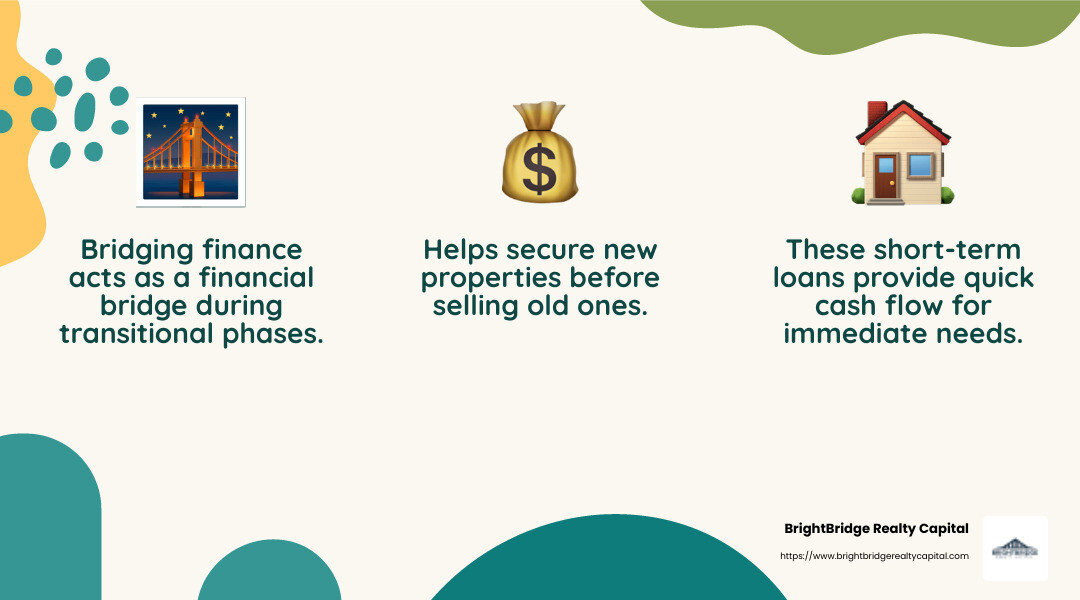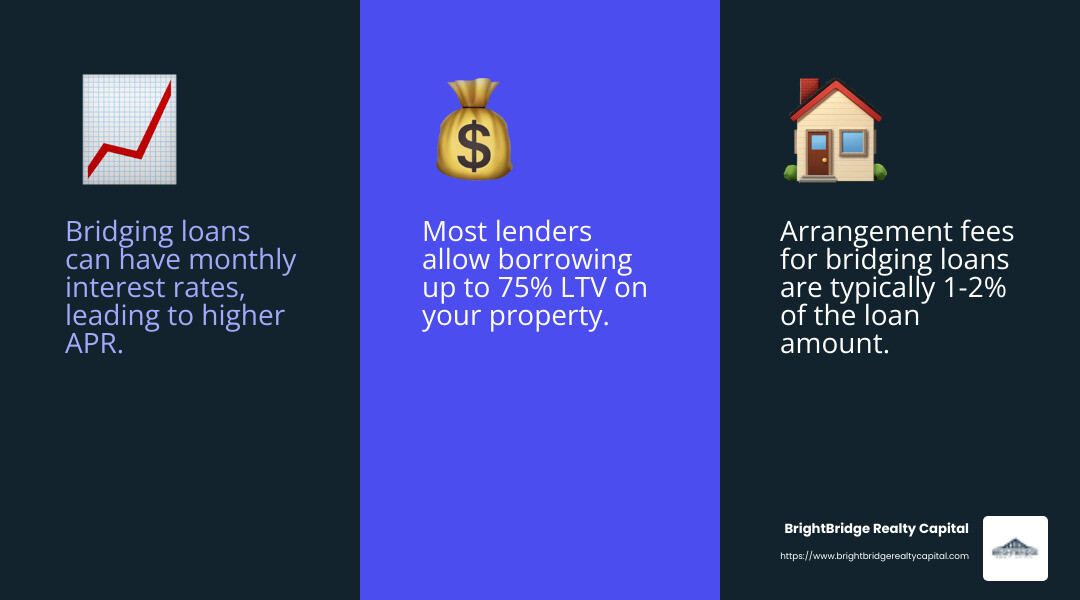Bridging Finance Explained: Your Guide to Short-Term Solutions

Bridging finance is an essential tool for real estate investors looking for fast and flexible funding to seize opportunities without the drawn-out processes of traditional loans. Bridging finance offers a short-term solution to fill financial gaps when timing is crucial—such as buying a new property before selling an existing one. Here’s what you need to know at a glance:
- Short-term loans: Typically lasts from a few months to a year.
- Quick access to cash: Ideal for situations needing urgent funding.
- Flexible use: Can be used for buying properties, renovations, or managing transitional expenses.
Bridging finance helps investors focus on expanding their portfolio by providing the temporary funding needed without the lengthy wait times associated with usual lending processes.
Real estate ventures often demand prompt action. Delays can mean missed opportunities and lost profits. That’s where bridging finance comes in, offering a lifeline with fast closings and minimal hassle. Ideal for fix-and-flip projects or expanding rental portfolios, it gives investors the edge they need in a competitive market.
"A bridge loan gives the homeowner some extra time and, more often than not, some peace of mind while they wait."
While this type of financing brings speed and flexibility, it is usually accompanied by higher interest rates compared to traditional loans. It's crucial to carefully consider the terms and ensure the finance fits into your overall investment strategy.

Common bridging finance vocab:
What is Bridging Finance?
Bridging finance is like a financial bridge over troubled waters, providing a short-term loan to cover gaps until long-term solutions are in place. Think of it as a temporary financial band-aid that helps you move forward when you're in between financial commitments.
Short-Term Loan
Bridging finance is all about short-term loans. These loans typically last anywhere from a few months to a year. They're designed to provide quick cash flow to meet immediate needs, whether you're an individual or a business.
Interim Financing
This type of loan is often referred to as interim financing. It's a stopgap measure that allows you to continue your financial journey without interruption. Whether you're waiting for a property to sell or a round of funding to come through, bridging finance can keep things moving smoothly.
Bridge the Gap
The main goal of bridging finance is to bridge the gap between your current situation and your future plans. For example, if you're buying a new home but haven't sold your old one yet, a bridging loan can provide the funds needed to secure the new property. This way, you don't miss out on opportunities simply because the timing isn't perfect.

Bridging finance is a versatile tool that offers quick access to funds when you need them most. It's a practical solution for those times when traditional loans just won't cut it due to their longer processing times.
While bridging finance offers many benefits, it often comes with higher interest rates. Therefore, it's crucial to have a clear exit strategy in place to repay the loan promptly and avoid potential pitfalls.
How Bridging Finance Works
Bridging finance is like a lifeline for cash flow, offering temporary funding when you need it most. It's designed to help you manage financial gaps with ease and agility.
Cash Flow Booster
Imagine you're in the middle of buying a new property, but your current home hasn't sold yet. You need money now, not later. That's where bridging finance steps in. It's a quick cash flow solution that ensures you have the funds right when you need them. This type of financing is especially useful in real estate, but it can also support businesses needing immediate working capital.
Temporary Funding
Bridging finance is all about temporary funding. It's not meant to be a long-term solution. Instead, it offers a financial cushion during transitional periods. Whether you're waiting for a property sale to finalize or a business deal to close, bridging loans provide the flexibility to keep your plans on track without delay.
Exit Strategy
Having a clear exit strategy is crucial when using bridging finance. Since these loans often come with higher interest rates, knowing how and when you'll repay the loan is essential. For example, if you're using a bridge loan to buy a new home, your exit strategy might involve selling your old home or securing long-term financing. Planning your exit ensures that you can pay off the loan promptly, minimizing costs and avoiding potential financial strain.
In summary, bridging finance is a short-term solution that helps manage cash flow during transitional phases. It's a practical tool for those needing quick access to funds, but it requires careful planning to ensure a smooth exit.
Types of Bridging Finance
When diving into bridging finance, understanding the different types is essential. Let's explore the key categories: first charge, second charge, and the distinctions between open and closed bridging loans.
First Charge vs. Second Charge
First Charge Bridging Loans: These are loans where the lender has the primary claim on the property. If you own your property outright or have no other loans secured against it, this is the type of bridging loan you might consider. In case of non-repayment, the lender can recoup their money first from the sale of the property. These loans typically offer better interest rates because they're less risky for lenders.
Second Charge Bridging Loans: If you already have a mortgage or another loan secured against your property, a second charge loan is what you'd be looking at. Here, the bridging loan lender ranks second in line for repayment, after your primary mortgage lender. Due to the increased risk for lenders, second charge loans often come with higher interest rates. Plus, you'll need the consent of your first charge lender to proceed.
Open vs. Closed Bridging Loans
Open Bridging Loans: These loans are for those who need flexibility. There's no fixed repayment date, which can be ideal if you're uncertain about when your funds will be available. However, the lack of a clear timeline can make these loans riskier and possibly more expensive. Borrowers typically use open loans when they're still in the process of selling a property or securing long-term financing.
Closed Bridging Loans: With a clear repayment plan in place, closed bridging loans are less risky for both borrower and lender. These loans have a fixed repayment date, often aligned with a known event, like the sale completion of a property. Because of the certainty involved, closed loans often come with more favorable terms.
In summary, choosing between first and second charge loans depends on your existing financial commitments, while deciding on open or closed loans hinges on your need for flexibility versus certainty. Understanding these distinctions can help you make an informed choice that aligns with your financial goals and timelines.
Now that we've covered the types of bridging finance, let's examine the costs and considerations involved.
Costs and Considerations
When considering bridging finance, it's crucial to understand the costs involved. These loans can be expensive, so let's break down the key elements: interest rates, fees, and the loan-to-value ratio.
Interest Rates
Bridging loans often come with higher interest rates than traditional loans. Why? Because they are short-term and carry more risk for lenders.
- Monthly Interest Rates: Unlike typical loans with annual percentage rates (APR), bridging loans often charge interest monthly. A 1% monthly interest rate translates to a 12.7% APR due to compound interest. A 2% monthly rate equals a 26.8% APR.
This means even a small difference in the monthly rate can significantly impact the total cost.
Fees
There are several fees to be aware of with bridging loans:
- Arrangement Fees: Typically 1-2% of the loan amount, these fees cover the setup costs.
- Valuation Fees: A property valuation is usually required, and you'll need to cover this cost.
- Legal Fees: Both your own and the lender's legal fees may be part of the process.
These upfront costs can add up, so it's important to factor them into your budget.
Loan-to-Value Ratio (LTV)
LTV is a key consideration. It reflects the amount you can borrow against the value of your property.
- Typical LTV: Most lenders allow you to borrow up to 75% of your property's value. However, first charge loans may offer higher LTVs compared to second charge loans due to lower risk.
- Impact on Rates: Lower LTVs can attract better interest rates because they represent less risk for the lender.
Understanding LTV is crucial as it affects both how much you can borrow and the cost of the loan.

In summary, while bridging finance can provide quick access to funds, weigh the higher interest rates, various fees, and LTV considerations. These factors will impact your overall borrowing cost and repayment strategy.
Next, we'll dig into how bridging finance is applied specifically in the real estate sector, exploring its role in property purchases, foreclosure situations, and renovation projects.
Bridging Finance in Real Estate
Bridging finance is a versatile tool in the real estate world, helping buyers and investors steer various scenarios. Let's look at how it plays a role in property purchases, foreclosure situations, and renovation finance.
Property Purchase
Imagine you're eyeing a new home, but your current one hasn't sold yet. A bridging loan can help you buy that new property without waiting. It acts as a financial bridge, allowing you to secure the new home and then repay the loan once your old home sells.
- Quick Moves: This is especially useful in competitive markets where waiting could mean losing out on a desired property.
- Auction Purchases: Bridging loans can also be handy for buying at auctions, where fast payment is needed.
Foreclosure Situations
In foreclosure scenarios, time is of the essence. Bridging finance can be a lifeline, providing funds to pay off overdue mortgages and prevent foreclosure.
- Avoiding Foreclosure: Homeowners facing foreclosure can use a bridging loan to settle outstanding debts, giving them time to sell the property on their terms.
- Reclaiming Control: This can offer breathing room to improve credit scores and explore longer-term financing options.
Renovation Finance
For property developers and investors, bridging loans can fund renovations, enhancing a property's value before resale.
- Fix and Flip: Use the loan to purchase a property, renovate it quickly, and then sell it at a profit. This strategy is popular among investors looking to maximize returns.
- Uninhabitable Properties: Bridging finance can also be used to refurbish properties that banks won't finance due to their condition, making them eligible for traditional mortgages later.
In real estate, bridging finance provides the flexibility and speed needed to seize opportunities, whether buying, preventing foreclosure, or renovating. It's a powerful tool, but weigh the costs and risks involved.
Next, we'll explore the custom solutions offered by BrightBridge Realty Capital, showcasing how they tailor bridging loans to meet unique client needs.
Custom Solutions by BrightBridge Realty Capital
At BrightBridge Realty Capital, we understand that every real estate investor's needs are unique. That's why we offer customized loan options custom to your specific situation. Whether you're flipping a house, building from scratch, or expanding your rental portfolio, we've got you covered.
Customized Loan Options
Our loan solutions are designed to fit your investment strategy. Need a 12-month bridge loan for a fix-and-flip project? We can do that. Looking for financing to kickstart a new construction project? We've got you covered there too.
- Flexible Terms: Choose from a variety of loan terms that match your project's timeline and goals.
- Diverse Products: From short-term bridge loans to long-term rental portfolio financing, our range of products ensures you get the right fit for your needs.
Expert Guidance
Navigating real estate finance can be complex, but you don't have to do it alone. Our team of experts is here to guide you every step of the way.
- In-House Experts: Our knowledgeable team handles everything internally, ensuring a seamless experience from start to finish.
- Custom Advice: We provide personalized guidance to help you make informed decisions and maximize your investment potential.
Fast Closings
In real estate, timing is everything. That's why we prioritize fast closings to help you seize opportunities without delay.
- Quick Approvals: Get pre-authorized swiftly and lock in your rate within hours.
- Speedy Funding: We often close deals within a week, providing the quick, hassle-free experience you need to keep your projects on track.
BrightBridge Realty Capital is committed to offering the speed, flexibility, and expertise you need to succeed in real estate investing. Our customized solutions are designed to meet your unique needs, ensuring you have the financial support necessary to achieve your goals.
Next, we'll dive into some frequently asked questions about bridging finance to help you better understand this powerful tool.
Frequently Asked Questions about Bridging Finance
What are the requirements for a bridging loan?
To qualify for a bridging loan, lenders typically look at two main factors: credit score and loan-to-value ratio (LTV).
Credit Score: A good credit score is crucial. Most lenders prefer borrowers with a score of 740 or higher. A higher score can lead to better terms and lower interest rates.
Loan-to-Value Ratio (LTV): Lenders usually allow you to borrow up to 75-80% of your property's value. This means you'll need at least 20-25% equity in your current property to qualify.
How long does it take to secure a bridging loan?
One of the advantages of bridging finance is the quick closing process.
Documentation: You'll need to provide some standard paperwork, including proof of income, property details, and your exit strategy.
Speedy Process: Once all documents are in order, lenders like BrightBridge Realty Capital can often approve and fund loans within a week. This speed is ideal for real estate investors who need to act fast.
What are the risks associated with bridging finance?
While bridging loans offer quick access to funds, they come with certain risks you should be aware of.
High Interest: Bridging loans typically have higher interest rates than conventional loans. This is due to their short-term nature and the quick funding process.
Foreclosure Risk: If you can't repay the loan on time, there's a risk of foreclosure. The lender can take your property to recover the loan amount, so it's crucial to have a solid exit strategy in place.
Understanding these requirements, timelines, and risks can help you make informed decisions when considering bridging finance. At BrightBridge Realty Capital, we're here to guide you through the process and help you steer these complexities with ease.
Conclusion
In real estate, timing is everything. Bridging finance offers a unique solution for those moments when you need to act fast but lack immediate funds. At BrightBridge Realty Capital, we understand the urgency and intricacies involved in real estate transactions. That's why we offer customized solutions custom to your specific needs.
Our expert team is dedicated to providing fast closings, often within a week, to ensure you never miss out on an opportunity. By cutting out intermediaries, we offer competitive rates and a seamless process, making us your go-to partner for real estate financing.
Whether you're looking to buy a new property, renovate an existing one, or steer a foreclosure, our nationwide services are designed to support you every step of the way. With our expertise and commitment to flexibility, BrightBridge Realty Capital is here to bridge the gap and help you achieve your real estate goals.
Explore how our customized loan options can make a difference in your investment journey. Let us handle the complexities, so you can focus on what matters most—growing your real estate portfolio.


